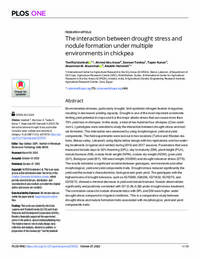The interaction between drought stress and nodule formation under multiple environments in chickpea

Authors:
Environmental stresses, particularly drought, limit symbiotic nitrogen fixation in legumes, resulting in decreased yielding capacity. Drought is one of the most important constraints limiting yield potential in crops and it is the major abiotic stress that can cause more than 70% yield loss in chickpea. In this study, a total of two hundred four chickpea (Cicer arietinum L.) genotypes were selected to study the interaction between drought stress and nodule formation. This interaction was assessed by using morphological, yield and yield components. The field experiments were laid out in two locations (Terbol and Kfardan stations, Bekaa valley, Lebanon) using Alpha lattice design with two replications and two watering treatments (irrigation and rainfed) during 2016 and 2017 seasons. Parameters that were measured include days to 50% flowering (DFL), day to maturity (DM), plant height (PLH), nodule biomass (NB), nodule fresh weight (NFW), nodule dry weight (NDW), grain yield (GY), Biological yield (BY), 100 seed weight (100SW) and drought tolerance stress (DTS). The results indicated a significant variation between genotypes, environments and other morphological, yield and yield components traits. Drought stress reduced significantly the yield and the nodule’s characteristics, biological and grain yield. The genotypes with the highest levels of drought tolerance, such as IG70399, IG8256, IG71832, IG70270, and IG70272, showed a minimal decrease in yield and nodule biomass. Nodule observations significantly and positively correlated with GY (0.36-0.38) under drought stress treatment. The correlation values for nodule characteristics with DFL and DM were higher under drought stress compared to irrigated conditions. This is a comparative study between drought stress and nodule formation traits associated with morphological, yield and yield components traits.
